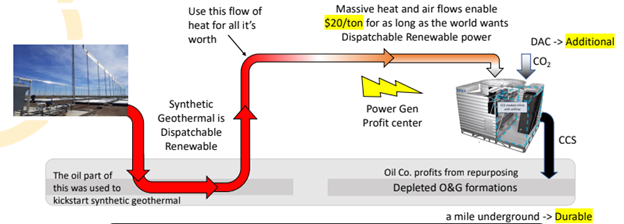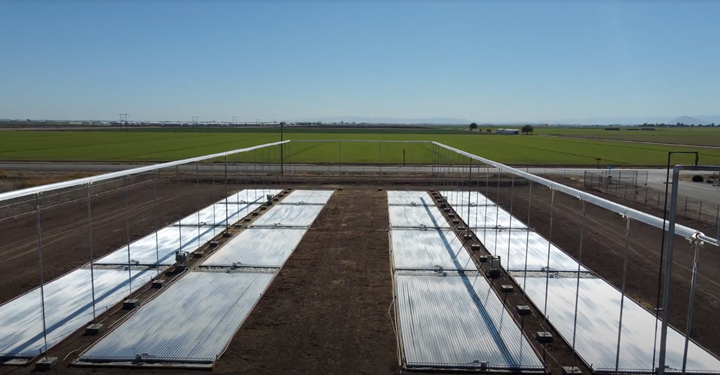The race to decarbonize the energy sector is fraught with many challenges. While some of these, such as identifying alternatives to fossil fuels, are underway in various stages of development and growth, the scale issue continues to loom overhead like a dark cloud of carbon. It’s one thing to install rooftop solar and batteries at a single-family residence, but this same strategy falls short for commercial and industrial (C&I) consumers demanding constant power at scale.
This demand for constant power at scale by C&I consumers represents one of the primary reasons for the incumbent success of the oil and gas (O&G) industry. Unlike residential energy users, C&I requires uninterrupted power for operational and business continuity purposes. For certain industries, the loss of power, for even a moment, can translate to significant losses in production and revenue, or, in some cases, even lead to loss of life. Think of all the backup generators (running primarily diesel fuel) at hospitals and data centers. The transition away from fossil fuels must present at least a similar level of capacity to gain the necessary acceptance and thus momentum to maximize decarbonization efforts. Particularly, when considering the huge investment in infrastructure made over time by O&G, subsidies notwithstanding.
Enter Hyperlight Energy:
Hyperlight Energy is an energy generation company building directly upon the existing infrastructure of legacy O&G. Hyperlight focuses on those wells that leverage enhanced oil recovery (EOR) as the basis for their two-part energy generation and storage solution. While these O&G assets seem at their end of life, their transformation as renewables may allow them to rise once again like a phoenix from the ashes.
The current IRR for solar/wind/battery projects for the C&I sector is around 6%, compared to 15% for O&G projects. In the eyes of Hyperlight Energy Founder and CEO, John King, this disincentivizes O&G to take on these renewable projects. However, by leveraging their existing oil recovery sites, these giants will have the opportunity to cost-effectively transition into renewables.
Turning Lead into Gold
There are two main components to the Hyperlight solution: Hylux™, a low-cost Concentrated Solar Power (CSP) product, and Tectonic Sun™, which effectively transforms the oil well’s substrata into a battery.

Traditional oil excavation uses natural gas to heat the rock within the oil well substrata to force the release of crude oil. CSP introduces solar energy as the heat source substitute thus reducing CO2E emissions. This solar source has never been taken advantage of before because most CSP solutions use expensive and complex steel structures to support the mirrors redirecting the solar energy and heat to the storage receiver. The Hylux platform consists of low-cost recyclable plastic tubes, instead of steel, as the mirror support structure for the CSP.
The solar energy then flows into the oil well to be used for extraction. However, excess energy can be captured by the rock substrata itself in the form of heat. The Tectonic Sun system allows the controlled release of this heat to be converted to steam onsite, which turbines can transform into electricity. This heat can be stored for months with no additional CO2E impact on the environment. This is effectively what Hyperlight calls synthetic geothermal.
The primary Hyperlight Energy use case focuses on oil wells in their last phase of productive life, as they leverage the solution to achieve an emissions-free EOR process. And once the crude has been fully extracted from the oil well, the Hylux™ and Tectonic Sun™ solutions can continue to capture and store clean solar energy for future power generation. This creates a low-cost path to capacity scaling renewables for O&G companies looking to transition using existing infrastructure.
Pilot programs in California and Saputo Inc. (dairy industry) are proving out the components of Hyperlight Energy’s products. While the California project is still ongoing, “Hyperlight estimates the statewide potential storage capacity of its technology to exceed the output of all the natural gas power plants in California, combined.”
The Competition
Hyperlight Energy competes in two markets at once – solar plants and battery technologies – and has the advantage that its unique solutions complement one another. While standard photovoltaic (PV) solar panels have plummeted in price, this technology is often coupled with battery technologies limited to four-hour durations. Hyperlight presents an option that reduces the cost of traditional steel-supported CSP and couples it with a longer-term battery duration, lasting weeks if not months. In particular, the Tectonic Sun Alpha project puts Hyperlight years ahead of its competitors.
Current competitors are also focused on more expensive solutions for alternate energy scaling such as solar hydrogen, or leveraging more geographically limited battery solutions such as direct molten salt. In contrast, Hyperlight combines three complementary renewable technologies (solar + batteries + wells) into a new offering that rewrites the rule book for geothermal.
The Market
Though 2021 saw a bit of a downturn in the global CSP market due to Covid-19, the market is expected to grow from $4.71B in 2021 to $8.04B in 2028, representing a CAGR of 9.3%. This is admittedly a capital-intensive market, but Hyperlight’s low-cost approach and focus on EOR use cases could position the company to grow at a much faster rate than the noted CAGR.
Outlook
With their tectonic Sun Alpha project, Hyperlight Energy expects to introduce a $100B TAM to energy companies within 100 miles of Bakersfield, CA. This leverages the 1B tons existing underground storage capacity associated with the EOR deployments at $50/ton. For those global O&G companies within the region, this project effectively de-risks the trial of the Hyperlight platform, allowing for future deployments to both end-of-life and defunct O&G assets.
Hyperlight’s outlook is quite sunny. (lol) California alone has over 100,000 oil wells with the potential to generate 100TWh of power using this solution.
Hyperlight Energy’s unique business model of working with O&G to deploy at the lowest possible cost with a built-in plan for additional energy and revenue generation after oil wells cease to produce may very well become the standard model that speeds up scale for the energy sector decarbonization.
About The Author

Brian most recently served as the CTO / CPO for PlanIT Impact, a SaaS platform focused on maximizing building resource (energy, water and stormwater) to cost performance for architects, engineers, and construction professionals (AEC) as well as building owners / operators. A life long advocate for climate change and environmentalism, his journey began most profoundly with the publishing of Al Gore’s “An Inconvenient Truth” and its subsequent activity culminating in the Live Earth concert. Since that pivotal event, Brian has followed climate change research closely with a particular interesting in environmental impacts, such as rising sea levels, shrinking biodiversity and deforestation. Currently, he is very interested in US-based efforts to drive consumer electrification, and the policy changes that need to occur to affect both supply and demand of renewables. Brian holds a BS in Computer Science from Trinity University and an MBA from University of Missouri-Kansas City Bloch School of Business.

